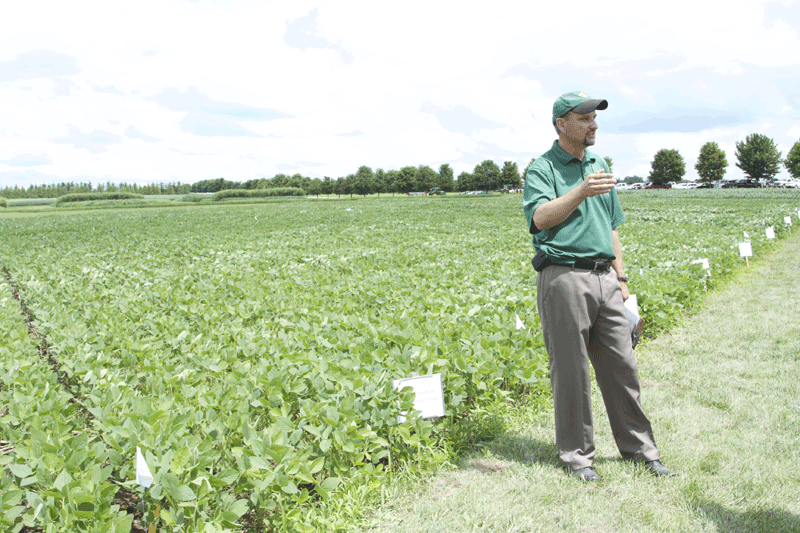The ‘kitchen sink’ method
A WINNING STRATEGY FOR SOYBEANS?
WHAT HAPPENS WHEN you throw everything but the kitchen sink on your soybean crop? Can you buy yield by applying additional inputs? And is it economically viable to do so? These are just a few of the questions explored in the Ontario Ministry of Agriculture and Food’s SMART II project, also known as the “kitchen sink” experiment.
PHOTO: HORST BOHNER EXPLAINS THE RESULTS FROM THE “KITCHEN SINK” EXPERIMENT – OMAF’S SMART II PROJECT.

WHAT IS THE “KITCHEN SINK” METHOD?
“In soybeans, we don’t even know how to significantly increase yield in a field that doesn’t have any problems in it, so we have to do the research to figure out how to increase yield first, and then work our way backwards to make it economical,” says Horst Bohner, Provincial Soybean Specialist with the Ontario Ministry of Agriculture and Food and Ministry of Rural Affairs (OMAF and MRA).
The kitchen sink experiment was a good first step towards answering some of those questions. The treatment used consisted of just about every input you could think of, including:
• Cruiser Maxx seed treatment
• Hi Coat inoculant
• Quilt foliar fungicide
• A 250,000-seed per acre seeding rate
• 50 lbs of nitrogen per acre (in the form of ESN and ammonium sulphate)
• Three gallons per acre of 2-20-18 liquid applied in furrow
• Six litres of slow release nitrogen
• Two litres of 3-16-16 foliar fertilizer
In the small plot experiments, this treatment package was applied on eight different varieties, chosen specifically to fit the area. In the field-scale trials, the same treatment was applied on two different varieties, one that was adapted specifically for the area, and another that was 200 crop heat units (CHU) longer than adapted.
RESULTS
The findings were clear. It is possible to buy yield – but at a hefty price. At a cost of $140 per acre, the average yield gain was only 4.1 bushels per acre – a boost that obviously is not profitable.
“When you start these things, you have no idea how they’re going to turn out,” says Bohner. “We were hoping that there’d be enough of a response to make it economically viable.”
“On the positive side, we had very consistent yield response across most of the varieties – on average five bushels, which is a very good number, actually.”
Interestingly, an additional 2.7 bushels per acre could be gained just by choosing a longer maturing variety – at no additional cost. Bohner says that choosing a soybean variety that is 200 CHUs longer than normal could be a winning strategy, particularly for those not going into winter wheat.
“You have to do some experimentation on your own farm, but we were very successful in growing one full maturity group longer than has typically been recommended in any given zone,” says Bohner. “So that would be equivalent to about 200 crop heat units longer without any issue at all in terms of finishing. That raises the question of what should we be growing for maximum yields in Ontario? Is it time to push that envelope further? And that’s part of the learning from that experiment.”
AGRONOMICS
From an agronomic standpoint, there were not many downsides to the experiment, other than some lodging.
“In the field situation, I would not choose to seed 250,000 seeds per acre, unless I was on very heavy clay,” says Bohner. “But for a lot of Ontario soils, that’s clearly too much if you’re going to apply the whole kitchen sink.”
On the plus side, the researchers seemed to be able to increase yields in the parts of the field that were suffering from various stresses. Whether that stress was due to root rot or low fertility, they were able to bring that part of the field up to match yields.
“In parts of the field where things are already quite good, you don’t need those inputs,” says Bohner. “But that gives us some hope that we can – through variable rate applications of these inputs – make it economically viable.”
Perhaps most surprising, were the experiment’s consistent results. “Basically, we had a statistically significant yield increase with our package 100 percent of the time,” says Bohner. “And that is one of the great problems in soybean research – trying to get consistent results – so this gives us hope that if we can get the economic side of it to work, that we may actually be able to employ it.”
The small plot data for the “kitchen sink” experiment is still being pulled together. That research will be released sometime this year, and should give researchers a better idea of where the response is coming from.
“We are working hard on making it practical to increase yields, but we have certainly been able to prove that these inputs do provide yield and that’s the first step.” •
Funding for this project provided by Grain Farmers of Ontario.







